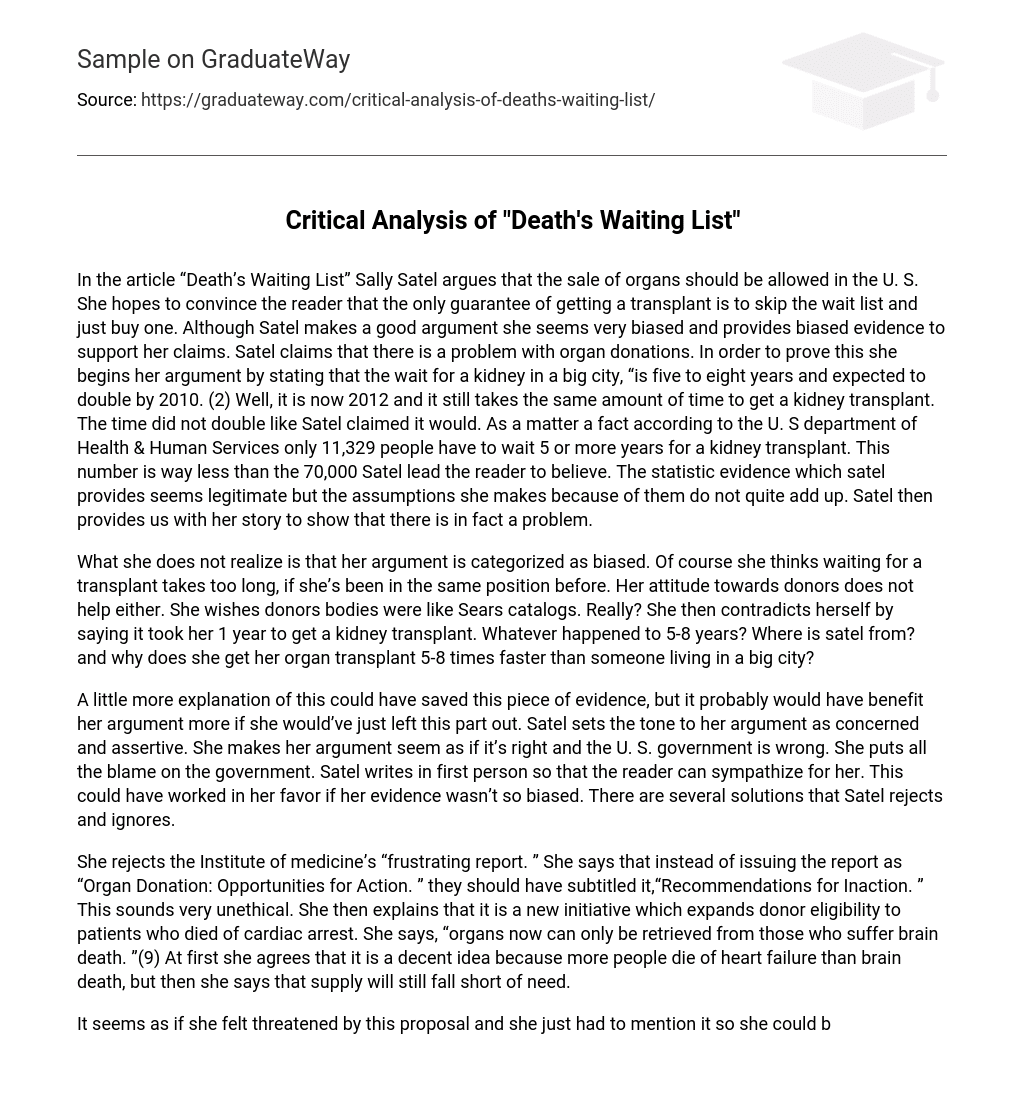“Death’s Waiting List” is an article by Sally Satel arguing for the legalization of organ sales in the U.S. Satel aims to convince readers that the only way to guarantee a transplant is by bypassing the wait list and purchasing one. However, her argument appears heavily biased as she offers biased evidence to support her claims. Satel asserts that there is a problem with organ donations, specifically noting that the wait for a kidney in large cities takes five to eight years and is expected to double by 2010. However, it is now 2012 and the wait time remains the same, contradicting Satel’s prediction. In fact, according to the U.S. Department of Health & Human Services, only 11,329 individuals have waited five or more years for a kidney transplant, significantly fewer than the 70,000 implied by Satel. While Satel’s statistical evidence appears valid, her assumptions based on them do not align. Furthermore, Satel shares her personal story to demonstrate that a problem does indeed exist.
What she fails to understand is that her argument is considered biased. Naturally, if she has previously been in the same situation, she will believe that waiting for a transplant takes too long. Furthermore, her negative attitude towards donors is not beneficial either. She desires donors to be readily available like items in a Sears catalog. Seriously? However, she contradicts herself by revealing that it took her only 1 year to receive a kidney transplant. What happened to the expected waiting time of 5-8 years? Additionally, where is Satel from? And why does she receive her organ transplant 5-8 times faster than individuals residing in larger cities?
If the writer had provided a little more explanation, it might have strengthened her argument, but it might have been more effective for her to omit this particular part. The tone of Satel’s argument is one of concern and assertion. She presents her argument as if it is correct and the U.S. government is wrong, placing all the blame on the government. Satel adopts a first-person narrative, possibly to evoke sympathy from the reader. This approach could have been advantageous if her evidence had not been so biased. Satel dismisses and overlooks several possible solutions.
She criticizes the Institute of medicine’s report, calling it “frustrating.” Instead of titling it “Organ Donation: Opportunities for Action,” she suggests it should have been titled “Recommendations for Inaction,” which she finds unethical. She then explains that the report introduces a new initiative to expand donor eligibility to patients who died of cardiac arrest. Currently, organs can only be retrieved from those who suffer brain death. Initially, she believes this is a good idea as more people die from heart failure than brain death. However, she later argues that the supply of organs will still not meet the demand.
It appears that the author felt threatened by the proposal and felt the need to mention it in order to criticize it in her article. Additionally, her counter argument seems weak in comparison to the proposal and lacks evidence to support her claim. Satel fails to provide any evidence to back up her claim, which is unfair. She mentions but overlooks the European Incentive, “Presumed Consent” (10), which essentially treats citizens as donors unless they explicitly opt out.
The potential impact of incentivizing organ transplants on the high demand remains unaddressed by the author. It appears that she did not discuss the incentive adequately due to a lack of strong arguments against it. Furthermore, Satel fails to provide a fair response to opposing viewpoints. Despite advocating for treating the body as a market, her solution for this approach has significant flaws and concerns. To support her argument, she presents an analogy that is not compelling. By comparing organ transplants to markets for human eggs, sperm, and surrogate mothers, Satel overlooks key distinctions. Unlike reproductive cells, organs cannot reproduce and solve the shortage in demand. Additionally, organs are not rented like surrogate wombs. As a psychiatrist, Satel should have known better than to use such a weak analogy. Lastly, Satel argues that compensating living kidney donors would benefit the poor rather than exploit them.
She argues that if organ donation was government regulated, donors could receive education, undergo screening, and receive follow-up care (13). However, she fails to address who will pay for these services. Will the government also be compensated? Will tax dollars be used? The details of how her solution would work are not fully explained. She does not effectively prove that compensation for organ transplants would be successful. The concept of enhancing quality of life through organ donation is questioned – is it only financially beneficial, not mentally or physically? It appears that she only considers finances as a measure of quality for the poor. One important factor she overlooks intentionally is who actually pays for the transplant – the health insurance company? How much will they cover? Will there be loans for uninsured individuals? What happens if the loan cannot be repaid? Would the organ be repossessed? Are there third-party organ repossession companies? How would they go about repossessing the organ?
The lack of information about where the organ will be repossessed is a crucial omission by Satel, perhaps intentionally to conceal her weak and biased argument. While it is evident that Satel recognizes the urgent need for organ transplants, her argument falls short and is biased. Consequently, she loses the reader’s interest right from the start of her article. To prevent this, she could have offered better solutions and provided more comprehensive and unbiased evidence to support her claims. However, she failed to do so, resulting in the unchanged state of the organ transplant system, which does not favor her stance.





